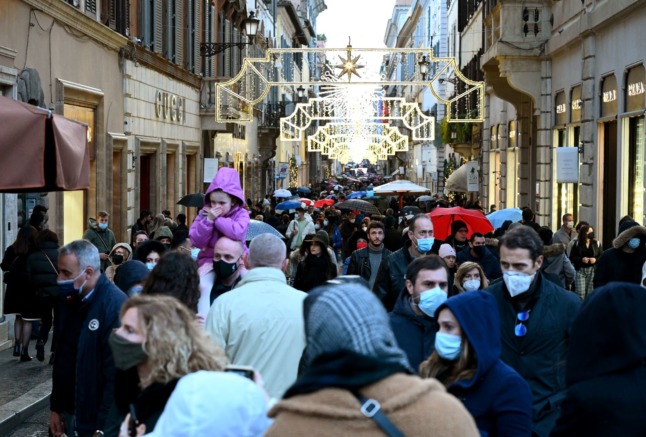The Italian regions of Liguria, Marche, Veneto and the autonomous province of Trento have been placed in Italy’s ‘yellow’ zone from Monday December 20th along with three other regions as they exceeded the government’s thresholds for hospital occupancy and coronavirus infection rates.
The rest of the country remains for now in the least-restricted ‘white’ zone, although a number of regions are expected to enter the more-restricted yellow zone in the coming days as their infection rates climb.
The government also recently introduced newnationwide Covid restrictions for the unvaccinated, which mean that from December 6th a ‘reinforced’ Covid health certificate or ‘super green pass’ is required to access many venues and services across the country, with the rules around exactly where the pass is required varying for different zones.
READ ALSO: ‘Super green pass’: Italy brings in new Covid restrictions on unvaccinated

The ‘super green pass’ is available only to those who are vaccinated against or have recovered from the virus – as opposed to the basic green pass, which can be obtained by testing negative for Covid every two to three days (depending on the type of test taken).
While the ‘super green pass’ is now required to access a large range of venues, the basic green pass is still valid in some circumstances, including to access public transport and to enter the workplace.
The government hopes the new requirements will increase vaccine uptake and enable vaccinated people in yellow and more restricted orange zones to go with life as normal in the lead up to Christmas.
At the time of writing, Italy’s health ministry has removed its official guidance relating to yellow, orange and red zone restrictions from its website. The Local has based this explainer on the government’s updated ‘super green pass’ guidance, and on Italian media reports.
Here’s what we know so far about Italy’s updated restrictions for yellow zone territories. We will update this page when the health ministry releases further official guidelines.
READ ALSO: EXPLAINED: How Italy’s Covid green pass rules change on Monday
Face masks
Unlike in the ‘white’ zone, yellow zone rules require face masks to be worn everywhere in public – including outdoors.
Eating out
Indoor dining can be accessed only by holders of the ‘super green pass’; however, dining outdoors at restaurants and eating and drinking while standing at the bar does not require any kind of pass.
Up till now, yellow zone rules have limited table sizes at restaurants to a maximum of four diners per table (unless all those seated were cohabiting).
The health ministry has not yet issued official guidance as to whether this rule will be maintained in yellow zones; however the Italian news daily La Repubblica reports that the four-diner-per-table limit is likely to be abolished with the introduction of the super green pass.

READ ALSO: Q&A: How will Italy’s new Covid ‘super green pass’ work?
Hotels
A basic green pass is now required to stay at hotels.
Indoor dining at the hotel requires a ‘super green pass’ in cases where the restaurant is open to anyone (not just guests).
In situations where the hotel restaurant is restricted to guests only, a basic green pass is all that’s required for indoor dining.
No pass of any kind is required to dine outdoors at hotel restaurants.
Curfew
As of December, no curfew is in place in yellow zones; everyone can freely circulate throughout the territory at any time of day or night.
Travel
Travel within and between white and yellow zones is unrestricted and does not require any justification.
Transport
A basic green pass is required to access all local and long-distance public transport. This includes local buses, trams, and metro services, as well as domestic flights, ferry journeys, and interregional train and coach services.
READ ALSO: Everything that changes in December in Italy
School buses carrying children under the age of 12, taxis, and private driver rentals for vehicles that have up to nine seats do not require any kind of pass; and you don’t need any kind of pass to travel in your own car.
Shops
Shops and shopping centres don’t require any kind of pass in the yellow zone.
Ski slopes, spas and thermal baths
A basic green pass is all that’s required in the yellow zone to gain access to these areas.

Gyms and pools
A basic green pass is required in yellow zones to access indoor gyms, pools, and other sports facilities, as well as changing rooms.
For open air facilities, no pass of any kind is currently required.
Theatres, cinemas, concerts, clubs and discos
A ‘super green pass’ is now required to access any of these in the yellow zone.
Sports events
A ‘super green pass’ is also required to attend sporting events and matches.
Museums, exhibits, cultural sites
A basic green pass will grant you access to any of these venues in the yellow zone.
Local authorities can decide to impose stricter rules at short notice. Always check the latest restrictions in your province or town: find out how here.
For further details about Italy’s current Covid-19 health measures please see the Italian Health Ministry’s website (available in English).



 Please whitelist us to continue reading.
Please whitelist us to continue reading.
Member comments